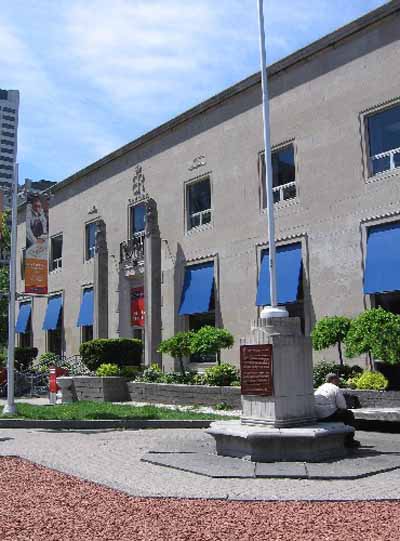Montgomery's Tavern National Historic Site of Canada
Toronto, Ontario

Detail view
(© Parks Canada Agency / Agence Parcs Canada, 2006.)
Address :
2384 Yonge Street (at Montgomery Ave.), Toronto, Ontario
Recognition Statute:
Historic Sites and Monuments Act (R.S.C., 1985, c. H-4)
Designation Date:
1925-05-15
Dates:
-
1837 to 1837
(Significant)
Event, Person, Organization:
-
Upper Canada Rebellion
(Event)
-
William Lyon Mackenzie
(Person)
-
James FitzGibbon
(Person)
-
Sir Francis Bond Head
(Person)
Other Name(s):
-
Montgomery's Tavern
(Designation Name)
Research Report Number:
2007-CED-SDC-09
Plaque(s)
Existing plaque: on base of flag pole on the grounds of Postal Station 'A' 2384 Yonge Street (at Montgomery Ave.), Toronto, Ontario
On this site stood Montgomery's Tavern, headquarters of William Lyon Mackenzie, leader of the Upper Canada Rebellion of 1837, the rebels were overcome by a force of militia commanded by Lieutenant-Colonel James FitzGibbon. Though unsuccessful in its primary objective, the uprising, by forcing the issue of unrequited grievnaces against the dominant "Family Compact", contributed significantly to the legislative union of Upper and Lower Canada in 1814 and to the establishment in Canada of responsible government.
Description of Historic Place
Montgomery’s Tavern National Historic Site of Canada is located in Toronto at the intersection of Yonge Street and Montgomery Avenue. The site, currently occupied by a post office, is marked by a Historic Sites and Monuments Board of Canada plaque affixed to the base of a monument and flagpole situated to the north of the building. There are no known extant resources from the original tavern and its exact dimensions and footprint in relation to the post office remain unknown. Official recognition refers to a five-metre radius around the Historic Sites and Monuments Board of Canada plaque.
Heritage Value
Montgomery’s Tavern was designated a national historic site of Canada in 1925 because: it was the headquarters of William Lyon McKenzie, leader in the Upper Canada Rebellion; it was the scene of a skirmish on December 7, 1837, which resulted in the collapse of the rebellion; and the rebellion was an important factor in bringing about the legislative union of Upper and Lower Canada, and the permanent establishment in Canada of responsible government.
In 1837, unable to establish fair government representation through political means, William Lyon Mackenzie, a reformer, newspaper editor, and the first mayor of Toronto (elected in 1834), assembled a group of moderates and radicals in an attempt to overthrow the existing government. Making Montgomery’s Tavern, located north of Toronto’s current boundaries, his headquarters, Mackenzie began his rebellion on December 5 when he and approximately 800 ill-equipped and untrained rebels began a march southward. The local militia repelled them before they could reach the city, and on December 7, Lieutenant Governor Sir Francis Bond Head ordered 1,000 militia and volunteers under Colonel James FitzGibbon to strike back. FitzGibbon’s forces were routed Mackenzie’s near Montgomery’s Tavern the same day, and the rebellion collapsed. The tavern was burnt down the same day. Though the rebellion was quelled, it was nevertheless instrumental in bringing about the establishment of responsible government in Canada, as well as a legislative union between Upper and Lower Canada, in 1841.
Sources: Historic Sites and Monuments Board of Canada, Minutes, May 1925, May 2007.
Character-Defining Elements
Key elements contributing to the heritage value of this site include: its location north of Toronto, at the intersection of Yonge Street and Montgomery Avenue; its setting in an urban environment, where the monument and Historic Sites and Monuments Board of Canada plaque is located; the integrity of any surviving or as yet unidentified archaeological remains which may be found within the site in their original placement and extent.